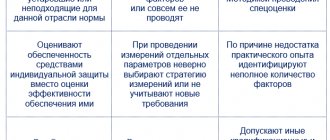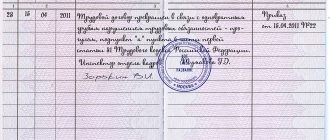Business assessment of personnel
Business personnel assessment is a targeted process of establishing compliance of the qualitative characteristics of personnel (abilities, motivations and properties) with the requirements of a position or workplace.
Based on the degree of this compliance, the following tasks are mainly solved:
choosing a place in the organizational structure and establishing the functional role of the employee being assessed;
development of possible ways to improve the business or personal qualities of an employee;
determining the degree of compliance with the specified criteria for remuneration and establishing its value.
In addition, a business assessment of personnel can help in solving a number of additional tasks:
establishing feedback with an employee on professional, organizational and other issues;
satisfying the employee’s need to evaluate his own work and quality characteristics.
Business assessment is a critical component of the personnel selection and development process.
There are two main types of business valuation:
assessment of candidates for vacant positions;
current periodic assessment of the organization's employees.
Both types of assessment allow solving basically similar (from the above) problems, therefore, in their formulation, the word “employee” should also be understood as “candidate for a position.”
Domestic and foreign practice of business assessment of candidates for a vacant position allows us to talk about four main stages that determine the content of the assessment process of this type.
These typical stages include: analysis of personal data;
making inquiries about the tested employee (at the place of previous work or study);
verification tests;
interview.
The current periodic assessment of an organization's employees usually comes down to two main stages:
(a) assessing the results of work and the factors determining the degree to which these results are achieved;
(b) analysis of the dynamics of labor productivity over a certain period of time, as well as the dynamics of the state of factors (conditions) influencing the achievement of results.
The organizational procedure for preparing a business assessment involves the following mandatory activities:
developing a business assessment methodology (if appropriate, such a methodology can be purchased) and linking it to the specific conditions of the organization;
formation of an assessment commission with the involvement of the immediate supervisor of the employee being tested, specialists from higher, equal and lower levels of the hierarchy, as well as specialists from the organization’s personnel management service or specialized assessment centers;
determining the time and place of the business assessment;
establishing a procedure for summing up the assessment results;
elaboration of issues of documentation and information support of the assessment process (formation of a complete set of documentation in accordance with the assessment methodology, its reproduction, distribution and determination of channels and forms of information transfer);
consultation of appraisers by the developer of the methodology or a specialist who knows it.
The main character in personnel assessment is the line manager. He is responsible for the objectivity and completeness of the information base necessary for the ongoing periodic assessment, and conducts an assessment conversation with the employee. The opinion of the future immediate supervisor is decisive when assessing candidates for a vacant position.
When forming the current periodic assessment, the following are summarized:
a) the opinions of colleagues and employees who have structural relationships with the employees being assessed;
(b) subordinates;
(c) specialists in the field of business assessment, as well as the results of employee self-assessment. In some cases, the commission includes a manager at a higher level of the organizational hierarchy (for example, the head of a functional subsystem, the overall management system of an organization).
The central issue of any business assessment is the establishment of its indicators. They can characterize both general aspects that are equal for all employees of the organization, and specific standards of work and behavior for a specific workplace or specific position.
In the first case, assessment indicators determine the employee’s belonging to a specific organizational and social system; in the second, the employee’s compliance with professional requirements.
With all the variety of assessment indicators, they can be divided into several groups:
labor productivity;
professional conduct;
personal qualities.
In assessing labor productivity, one should distinguish between the so-called “hard” and “soft” indicators.
“Hard” indicators are quite easily measurable and are, as a rule, covered by the organization’s information system. Indicators of this type can be formulated subjectively by the developer of the assessment methodology, but they must be amenable to fairly objective quantitative assessment, for example, by the manager.
The production system of the organization, as well as the divisions of the management system that have pronounced relationships with the external environment, are most consistent with the “hard” indicators: the marketing department, the logistics department, the chief mechanic department, etc.
“Soft” evaluation indicators are determined by their dependence on the subjective opinion of the evaluator and are used in departments with limited ability to measure a specific result (for example, in research departments).
Despite the importance and priority of labor performance indicators, you should always remember the following rules:
do not give clear preference to any one indicator or to a given group of indicators in general, as this leads to employees neglecting other, often equally important aspects of activity;
determine the necessary and sufficient number of indicators so that, on the one hand, they cover all the essential aspects of labor productivity, but, on the other hand, do not overload the assessment.
These rules are important not only for this, but also for subsequent groups of indicators. Indicators of professional behavior are conventionally divided into factors (or conditions)
achievements of labor results and indicators of direct professional behavior.
Did not you find what you were looking for?
Teachers rush to help
Diploma
Tests
Coursework
Abstracts
The factors (or conditions) for achieving labor results are understood mainly as the ability or desire to perform general management functions both in relation to other objects of influence and in relation to oneself: planning activities, organizing and regulating the process, accounting and monitoring the progress of work.
In other words, these indicators characterize the degree to which an employee creates his functional role.
Indicators of direct professional behavior cover such aspects of activity as cooperation and collectivism at work, independence in solving certain problems, readiness to accept additional responsibility or additional workload, etc.
At the same time, it is important to take into account the fact that directly observable behavior is really necessary when performing work and that its inclusion as an evaluation criterion does not interfere, but rather contributes to the achievement of certain results (in some cases, these results can be considered as joint for the interacting parties).
When developing these indicators, it is important to specify them, which will weaken or eliminate the possibility of multiple interpretations on the part of the appraiser.
The third group of assessment indicators is personal qualities. Despite its apparent simplicity, this group of indicators is associated with great problems in their selection, formulation and accounting.
This is due to a wide range of personal qualities, significant subjectivity in their perception and an increased likelihood of violating the rules for choosing criteria that were formulated earlier when considering performance indicators.
The main problem lies in the lack of possibility of direct observation of personality properties.
If we observe people while they perform a certain job, then we can talk mainly about their behavior or the results achieved and, to a lesser extent, about personality traits.
The difficulty lies in the fact that any pattern of behavior can be the result of the action of unmanifest personality traits. An unambiguous assessment of these properties is possible with repeated and fairly constant observation of the employee, which is actually a very difficult matter and often leads to a distorted perception of the employee by the appraiser, since the systematic assessment is not ensured.
At the same time, a certain personality property can be considered as the potential to achieve a result for one person, but for another it may not be such.
These features of the use of personal characteristics as indicators of personnel assessment require a careful and balanced approach with mandatory combination with other groups of indicators.
One of the most important issues when conducting a business assessment of personnel is the choice of methods by which certain indicators are assessed.
In any case, the method or method of assessment should ensure the greatest possible objectivity in measuring specific indicator values. It is necessary to point out the importance of observing the following condition in the assessment methodology: the need for a detailed description of the quantitative and qualitative interpretation of the possible states of the indicator.
In this case, we are talking about the desire to minimize the subjectivity of assessments, since it is hardly possible to find a way to achieve their complete objectivity.
The principles for distinguishing two groups of assessment methods can be formulated as follows:
evaluation indicators are predetermined;
the appraiser is free to choose these indicators.
When using methods with preliminary establishment of evaluation indicators, the developer of the evaluation system determines what should be evaluated and what signs the appraiser focuses on.
When assessing, you can use several methods that determine the features of identifying specific indicator values:
the characteristic value is set on a scale for each employee (scaling method);
several estimates are ranked in relation to one value (rank ordering method);
an individual employee is characterized in terms of the presence or absence of the proposed indicator value (method of alternative characteristics).
The scaling method can manifest itself in two forms: the gradation method and the method of rating scales with a description of quantitative assessment. With the gradation method, the evaluator is offered a scale with points for determining the values of indicators, and these points represent the degree of expression of the indicator.
An example of the use of the gradation method is illustrated below:
This method, which resembles a school grading system, does not involve large development costs and is therefore convenient and economical. But this raises a certain number of problems.
The numerical designation of the severity of the indicator makes possible a wide field of interpretation for the appraiser (for example, depending on the level of his own claims). In grading, these are called errors of leniency or severity. There are raters who tend to make judgments either on the extreme (1 or 5) values ("tendency towards extremes") or on the average values of the scale ("tendency towards the middle").
To reduce subjectivity when using the gradation method, another type of scaling is used - the method of rating scales with a description of quantitative assessment. In this case, the numerical values of the scale are interpreted with a more detailed description of the course of action corresponding to a given numerical value. The differences will be in the scope and degree of specificity of individual descriptions.
The quality of this method increases with increasing specificity of the description of the scale segments. In this case, one should strive to directly reflect the requirements for the workplace (position) in the scale. This results in a lower susceptibility to distorted assessments.
The next evaluation method is the rank ordering method. Sometimes a situation occurs that many employees can be compared only on individual scale values that correspond to two gradations.
In this case, it is necessary to maintain differentiation between employees (for example, according to the salary scale of a certain category of employees). Such differentiation in business assessment of personnel is achieved using the “rank ordering method”, which, however, is rarely used in practice.
As part of the analytical assessment, a ranked series is compiled for each indicator, for example: the indicator “fair execution of orders”: employee 1 > employee 2 > employee 3.
The total (generalized) assessment of employees is calculated by adding individual ranks. The method under consideration has a number of disadvantages: non-standardized time spent when assessing large groups of employees, the inability to compare groups. It is also impossible to make a reliable conclusion about the qualitative distance between the two objects being assessed: the difference in work results between employees 1 and 2 can be large, and between employees 2 and 3 - insignificant. These differences cannot be discerned from the rank ordering.
The alternative characteristics method differs from the previous ones in that it does not use systematic measurement methods. The appraiser is offered a list of statements about the employee’s image. The evaluator notes the correspondence or inconsistency of a particular statement with this image.
In addition to the assessment methods discussed above, there is another type: a method without preliminary establishment of assessment indicators.
This method establishes the course of the assessment process, but without first defining the assessment criteria. The assessment process develops substantive and job-specific job performance measures.
The appraiser becomes more independent and flexible in choosing specific methods of conducting the assessment.
The key idea of the method lies in measuring the results and efficiency of employees' work, which establishes the employee's contribution to achieving the organization's goals.
This method involves the following sequential steps:
a) goals are set for each employee for a specific period. At the same time, the expected labor contribution is determined and, based on the established goals, evaluation criteria are developed at the end of a given period of time;
b) after its expiration, the results are evaluated - both by the manager and by the employee himself.
The introduction of self-assessment improves the information base of business assessment. Differences in assessments of one event are discussed within the framework of evaluative conversations;
c) the manager points out opportunities for improvement and development of the employee’s activities, and also, together with the employee, determines goals for the new period.
The versatility of business assessment of personnel is achieved through the use of so-called “evaluation sheets”, which are filled out by all participants in the business assessment process.
“Rating sheets” are filled out by all evaluator parties (colleagues, direct management, subordinates, employees of related departments who have working contacts with the employee being evaluated). All completed forms are sent to the immediate supervisor of the employee being assessed.
The manager gives his own conclusion on the submitted assessments and introduces it to the employee. The manager submits his conclusion and forms of “Evaluation sheets” to the personnel management service.
In turn, this service should include in the personnel reserve for nomination employees who received the highest scores during the last two or three planned assessments, and also require detailed explanations from the manager if his opinion on certain indicators of the assessment of any employee differs from the opinion of the majority appraisers.
Goals, principles and object of assessment
Page 1 of 3Next ⇒
Lecture 13. BUSINESS EVALUATION OF PERSONNEL
The purpose of the lesson is to form in students the concept of the system and principles of organizing business assessment of personnel, as well as the place of this technology in the process of personnel management of an organization.
Tasks:
• determine the place of technology for business assessment of personnel in the personnel management system and identify the areas of personnel decision-making in which assessment results are used
• characterize the business assessment system in the organization and formulate the principles of employee assessment
• analyze the content of the main stages of the assessment
• provide an analysis of errors made in the business assessment process and ways to minimize them
• formulate recommendations that the HR manager should adhere to when communicating the assessment results to employees.
PLAN
13.1. Goals, principles and object of business assessment
13.2. Ways to minimize errors in the assessment process
13.3. Communicating assessment results to employees
Goals, principles and object of assessment
Employee assessment, without exaggeration, is the core of all personnel work, since all personnel decisions are, to one degree or another, based on its results. The place of business assessment in the personnel management system is presented in Figure 13.1. Without assessing the personal qualities, abilities of employees and the results of their activities, it is impossible to correctly select the most suitable candidates for work in the company, determine their training needs, career development prospects, establish a fair level of remuneration, and form a reserve for management positions. Moreover, depending on the purposes of the assessment, the question will be decided which characteristics of workers and indicators of their work activity are subject to assessment, and which of the existing assessment methods best meet the achievement of the goals. For example, when justifying wages, the main object of assessment should be the specific results of the employee’s work, while for career planning, the greatest interest will be in assessing the abilities and potential of employees. However, despite the importance of specific goals, the general purpose of evaluation is to increase the efficiency of workers.
The frequency of use of assessment results in various areas of decision-making in Russian companies is presented in Table 13.1.
Figure 13.1. The place of business assessment in the personnel management system
Table 13.1
Objectives of the assessment
| Sphere of decision making | Frequency of use of assessment results |
| Justification of decisions in the field of wages and bonuses | 85,6 |
| Improving labor efficiency | 65,1 |
| Determining Training Needs | 64,3 |
| Employment regulation, career planning | 45,3 |
| Individual planning for performance improvement | 43,1 |
| Imposition of disciplinary sanctions. Layoffs | 30.3 |
| Research Use | 17,2 |
Business personnel assessment is a purposeful, organized process of determining the compliance of the qualitative characteristics of personnel and the results of their work with the requirements of a position or workplace. Formal methods of personnel assessment began to be used by foreign firms in the mid-twentieth century, but the active use of assessment as a technology of personnel management began in the 70s. last century.
The business assessment system performs a number of important functions:
firstly, the administrative function,
since the assessment results provide management with the opportunity to make informed decisions on salary differentiation, promotion or dismissal;
secondly, the information function
. Assessment of labor results is necessary to inform the employee about the level of his work, the strengths and weaknesses of his activities and professional behavior, and reserves for improvement. Business evaluation is a form of feedback in an organization;
thirdly, a motivating function,
which is expressed in the fact that the results of a business assessment stimulate the employee to improve his skills and productivity.
One of the main conditions for obtaining the best results of a business assessment is its organization. A properly organized assessment process consists of a number of stages.
First stage
– development of a business assessment methodology. At this stage the following tasks are solved:
· determination of personnel assessment goals
· establishment of assessment indicators (criteria) or competency models
· determination of the type of assessment
· development and justification of assessment methods.
.
As a rule, the purpose of the assessment determines the activities carried out to organize it, the methods, methods of the assessment itself, and its procedure. Thus, to obtain information about relations between employees, it is necessary to organize a survey of them, conduct interviews, and analyze documents. To identify weak divisions of an organization according to various criteria, it is necessary to compare their performance indicators with other similar divisions and organize a production and statistical analysis of their work over time.
Next, evaluation indicators (criteria) . Assessing people is a very sensitive area that requires an individual approach. It is sometimes called the “Achilles heel” of managers. It is important to use the necessary and sufficient number of indicators, without giving preference to any one of them. Taking into account the variety of indicators, they are conditionally divided into several groups.
The first group includes indicators characterizing employee labor costs
, their intensity, complexity of the work performed, features of the organization of the work process.
The second group includes indicators that evaluate labor results
, including direct and indirect. An indicator of direct results is, for example, the amount of products produced by an employee in a certain time. Indirect results, unlike direct ones, indicate the influence of the work of some workers on others. Other indicators of labor productivity are the number of products produced, the volume of their sales, the degree of use of resources, the labor intensity of a unit of production, profitability, etc. These indicators are easily measurable and are used to evaluate personnel in logistics and marketing. For example, the performance of an employee of a trading company can be assessed based on the total sales volume in the service territory and the increase in the number of new customers.
The third group is indicators of professional behavior, including: ability to cooperate, communication skills, sense of responsibility, etc. The need to evaluate them is due to the fact that in many cases it is difficult to assess the implementation of specific tasks that may be directly assigned to one or another performer . This is especially relevant to those workers who work in a group (or the product of their work is the result of a group effort). In this case, the result of the group’s work is easy to determine, but it is sometimes almost impossible to clearly establish the contribution of everyone. In this case, the employee can ultimately be evaluated based on his behavior. For example, we can conditionally assume that a seller who is polite and attentive to customers, knows how to present the product well, and, as a rule, has higher sales volumes. On the contrary, negative behaviors identified during the assessment process may indicate miscalculations in the field of personnel selection.
The fourth group should include the personal qualities of the employee - decency, sensitivity, honesty, integrity, etc. Assessing these qualities is often subjective and therefore requires some caution. In addition, personal qualities are not always directly related to job performance.
Second phase-
identification of subjects of assessment.
The next area of decision-making when carrying out personnel assessment is related to the choice of the subject of the assessment. When defining a subject, there are a number of serious problems that need to be addressed. Among them are the following: who should be entrusted with conducting a personnel assessment - one appraiser or a group, employees of a given enterprise or independent outside experts, etc.
At a number of Russian enterprises, the “360 degree principle” successfully works when determining the subject of personnel assessment. In accordance with it, the following may be involved in assessing an employee:
· immediate supervisor of the person being assessed
· Colleagues
· subordinates (if the manager is assessed)
· independent experts
· clients
· the employee being assessed (self-assessment results).
In this case, the criteria for choosing the most successful solution to this problem will be:
Ø capabilities of appraisers (who knows the employee better)
Ø their abilities (knowledge, experience, individual qualities of the appraiser, for example, fairness and objectivity)
Ø motivation (who is most interested in receiving an objective assessment).
It should be borne in mind that the main character in personnel assessment is the line manager. He is responsible for the objectivity and completeness of information, summarizes the opinions of fellow experts and employees.
The correct choice of an appraiser or group of appraisers will minimize the risks associated with manifestations of subjectivity, avoid unwanted prejudices and stereotypes when assessing personnel and making the necessary personnel decisions on its basis. It must be borne in mind that in the process of assessing employees, errors and misconceptions often arise, the consequences of which should be known in advance to the specialists conducting the assessment.
Third stage -
development of an assessment procedure as a sequence of actions. At the same time, the place and time of the assessment, those responsible for its conduct, and the work procedure of the expert commission are determined.
Fourth stage
– conducting personal assessments of personnel in various forms, summarizing the information received, preparing and conducting an assessment conversation.
Fifth stage –
summing up the assessment results, making decisions based on the assessment results.
QUESTIONS FOR SELF-CONTROL
1. What is business assessment of personnel? What are the main purposes of business assessment?
2. What functions does business assessment perform in the personnel management system?
3. Name the principles of business assessment and reveal their content.
4. What is meant by evaluation criteria and indicators? How do the concepts of “assessment indicators” and “competency model” relate?
5. Which groups of indicators are commonly used and why?
6. What considerations should be used when determining the subjects of assessment?
7. Why are assessment results not always communicated to the employees being assessed? What problems does the HR manager need to solve in the process of communicating the results of the assessment?
8. What are the common mistakes appraisers make? How to avoid these mistakes?
9. How is the assessment process organized at the company where you work? How can this process be optimized?
10. Formulate the basic rules for conducting assessment conversations.
MAIN LITERATURE
1. Kibanov A.Ya., Durakova I.B. Organizational personnel management: selection and assessment during hiring, certification: Proc. manual for university students. - M.: Publishing house "Examination", 2004.
2. Technologies of personnel management: Textbook and practical guide / Ed. I.V.Mishurova.- M.: ICC “MarT”, 2004.
3. Personnel management in production: Proc. manual for universities / Ed. prof. Shatalova N.I., N.M. Burnosova. - M.: UNITY-DANA, 2003.
4. Personnel management of an organization: Textbook./ Ed. A.Ya.Kibanova. - M.: INFRA-M, 2006.
ADDITIONAL LITERATURE
1. Analysis of the results of the interview // Personnel Management, 2006.—No. 1.
2. Dashyan M. Non-traditional forms of assessing candidates when hiring // Personnel Management, 2004.—No. 20.
3. Ivanov Yu. Comprehensive assessment of industrial enterprises//Personnel Management, 2003.—No. 12, p. 65.
4. Lobanov A.S. Accurate methods of personnel assessment//Handbook of personnel management, 2004.—No. 7.
5. Makarova L.V. Methodology for assessing human potential // Handbook of personnel management, 2006.—No. 9.
6. Melnikov E.F. “Golden reserve” of the company // Handbook of personnel management, 2007.—No. 6.
7. Napolov R. System for assessing key employees of the company // Personnel Service, 2005. - No. 2.
8. The concept of a non-traditional method of personnel assessment // Personnel Management, 2006. - No. 1.
9. Techniques for preparing and conducting effective interviews // Personnel Management, 2006.— No. 1.
10. Utkina M.A. Employee self-assessment system // Handbook of personnel management, 2007.—No. 8.
1Next ⇒
Recommended pages:
Use the site search:









